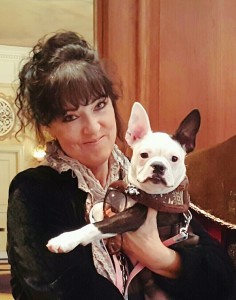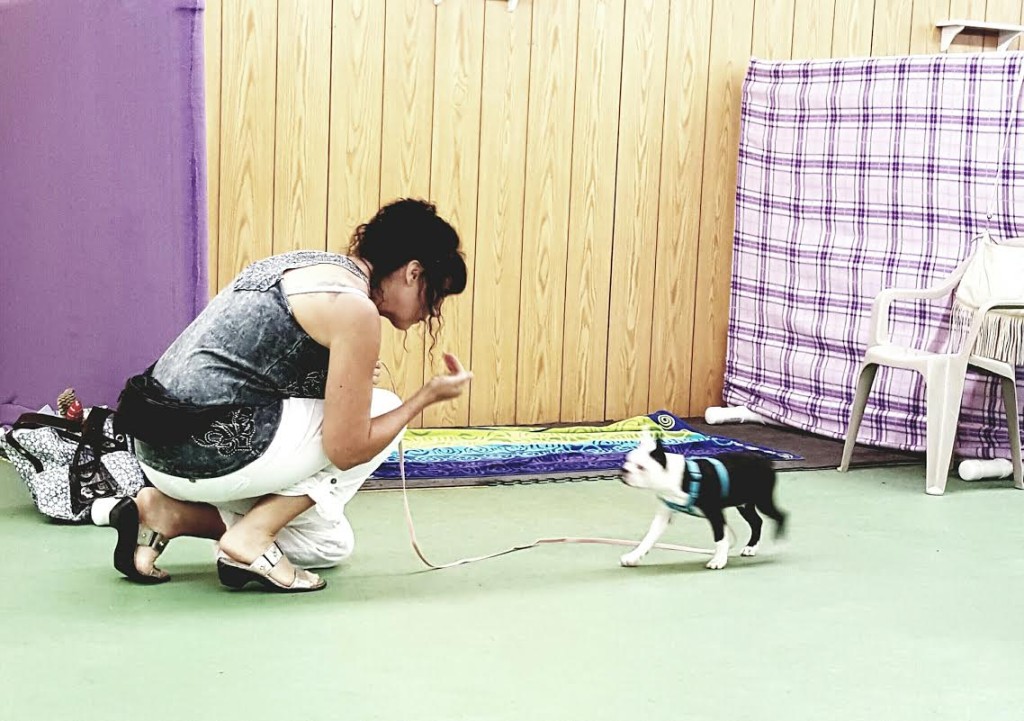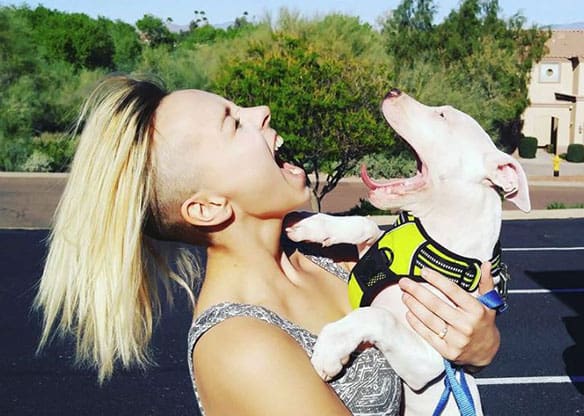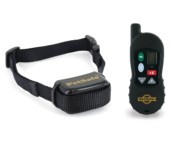This article by Paul Klein captures the essence of living with and training a deaf dog. Paul is right on point when he writes “It is vital to bear in mind from the outset that deaf dogs respond when their handlers talk to them. They can’t hear, but they observe and respond to countenance and body posture as much and possibly more than hearing dogs do. To a deaf dog, these things are equivalent to tone of voice.” I hope you all enjoy this article as much as I did.

According to my deaf dogs Nitro, Bud, Bowie and myself, Paul Klein totally ROCKS! Happy deaf dog training Rockers!
~ Christina Lee – DDR
Deaf puppy Bowie’s first Positive Reinforcement Group Training Puppy Class
This article comes from Tell Me You Love Me on the Association of Pet Dog Trainer’s Official Website.
This essay was written by Paul Klein in which he won 1st Place in the APDT Essay Scholarship Competition.
What’s Different, And What’s Not, About Training Deaf Dogs By Paul Klein
Novice owners of deaf dogs commonly feel desperate. The dog’s condition often is a surprise. The owner acquires a dog from a breeder or shelter, falls in love, and then learns it is deaf. Frequently, the provider of the dog is willing to take it back with the understanding it will be euthanized. Just as frequently, misinformed trainers state flatly that the dog can’t possibly lead a normal life, or even be expected to perform as hearing dogs do in obedience class. In short order, the joy of acquiring a new dog turns to dread and isolation.
A measure of dread is typical among many first-time owners. Isolation, on the other hand, is relatively rare. There are no end of classes, books, magazines, videos and cultural icons available to make the novice owner of a hearing dog feel at minimum that they’re not alone in what they’ve taken on, even if they are a bit intimidated by all those chewed shoes, holes in the garden, and disappearances from the kitchen counter. This article is intended to address that disparity by giving trainers who have relatively limited experience with deaf dogs, and owners who have fallen in love with their first, basic advice on how to proceed.
What’s Not Different About Training Deaf Dogs
There is little to no reason to think deaf dogs don’t learn in the same way as hearing dogs – or for that matter, aardvarks and zebras – and every reason to think they do. The laws of classical and operant conditioning apply to all. Likewise, house, crate and chew training – the urgent essentials of blissful interspecies cohabitation – remain the same. It is up to the trainer, while acknowledging the client has taken on some special challenges, to normalize the dog’s needs and get creative about addressing them as one would with any dog.
It is vital to bear in mind from the outset that deaf dogs respond when their handlers talk to them. They can’t hear, but they observe and respond to countenance and body posture as much and possibly more than hearing dogs do. To a deaf dog, these things are equivalent to tone of voice. Owners often benefit from practicing obedience requests in front of a mirror with an emphasis on looking like they mean what they say: a hand cue for “good dog,” for example, should be accompanied by a happy facial expression and upright posture, while one for “warning – stop that behavior” may be accompanied by a bit of frowning and hunching. It is equally useful to practice a blank as possible countenance for those times when the dog displays unwanted behavior, such as whining while crated, but neither approval nor disapproval is on the training agenda. And, just as verbal cues and tone of voice must be appropriate to the handler’s goal when training hearing dogs, hand cues and countenance must likewise match the handler’s goal for a deaf one. That is, we should never lie to dogs, hearing or deaf. If baths are torture, for example, it’s best to go blank and point to the tub, and unacceptable to put on a happy face, cue “come,” and commence the torture.
Finally, deaf dogs require socialization to dogs and people. While this is the furthest thing from a surprise to experienced trainers, novice owners often are tempted to “protect” deaf dogs that they perceive, even with the best intentions, as disabled. One common error is keeping the deaf dog from interacting with other dogs for fear it will miss warning growls. In fact, deaf dogs readily perceive any number of signals from other dogs – hard stare, stiffening, tucked tail, etc. – and while they likely do make occasional errors in judgement because they cannot hear, these are no more dangerous than the occasional errors made by hearing dogs.
Socialization to people, of course, cannot be overemphasized for any dog, and is arguably an even more urgent matter for a deaf one because they cannot hear the solicitous tone of voice that people use when greeting. Thus, in addition to exposing a deaf dog to a great number of friendly persons bearing treats, owners are well-advised to train a socialization cue by pairing a hand gesture – my personal favorite is arms outstretched, palms down, fingers wiggling in a tickling motion – with food and affection. The dog rapidly learns that people in general, and particularly those who wiggle their fingers, predict good things.
What’s Different About Training Deaf Dogs
1. Attention
Little so stymies a novice owner of a deaf dog, at least initially, as getting the dog’s attention when its gaze is directed elsewhere. As a daily practical matter, the solution is contextual. If the dog is standing next to us, and we want to cue “down,” we can pat the dog. If we’re indoors, and we want to cue “come” from some distance away, we can tap a foot to the floor, rap on a table, or turn a light on and off. Ad hoc actions such as these account for much of life with a deaf dog.
A vibrating collar is useful for getting a deaf dog’s attention in distracting environments. Many are commercially available; alternatively, do-it-yourself types can search the Internet for instructions on assembling one from scratch. The vibrating component, attached to a conventional collar, is typically more or less the size of a nine volt battery. Controlled by a remote transmitter, it emits a sensation like a pager. Some have a simultaneous tone feature that lets the handler know, assuming the handler hears, the collar is working properly.
To condition the collar, work in a non-distracting environment and begin by desensitizing its vibration. Show the collar to the dog and dispense food from the hand that holds the collar (the transmitter is in your other hand). Hold the collar such that it barely touches the dog’s neck, activate the vibrator, and dispense food. Do several repetitions. Hold the collar more firmly against the dog’s neck, activate the vibrator, and dispense food. Do several repetitions. Put the collar on the dog, activate the vibrator, and throw open the doors to the smorgasbord. If holding the collar, transmitter, and food in two hands feels cumbersome, an assistant can operate the transmitter up to the point when the collar is on the dog.
A vibrating collar has many applications. It can be used to get a dog’s attention in obedience class or at a dog park (deaf dogs are by no means barred from off-leash recreation so long as they are trained, like any dog, to be attentive to their owners and come when requested), to mark desired behavior just as a clicker does, and to work as a conditioned stimulus to countercondition fear and aggression. In many breeds, congenital deafness is often coupled with sight-impairment. When this is not the case, the handler may find the rapid action of a flashlight is more precise than the buzz of a vibrating collar used in lieu of a clicker.
Ultimately, the choice of how best to get a deaf dog’s attention frequently depends on what the handler wants to accomplish and the inclinations of the dog. For example, I recently demonstrated at a local animal shelter how not to desensitize a deaf dog to a vibrating collar. My attempts were sloppy and rushed, and resulted in a dog bothered by the collar and disinterested in turning his attention to me when paged. The agenda for that dog was to train a behavior that was incompatible with chasing – “turn and look at the handler” – when prey was in the environment. As it turned out, the collar was completely unnecessary. Shelter staff subsequently informed me that the dog was happy as could be to turn and look at the handler when given a soft tap on the side.
2. Hand cues and timing
Hand cues are the primary means of communicating with a deaf dog. Some, such as the upward sweep of a hand for “sit” and its downward sweep for “down,” follow so readily from lure-reward training that there is little if any reason to change them. Others, such as an index finger across one’s lips for “shush” or an outstretched arm and flat palm for “stay,” often are intuitive. There are three useful principles for devising and using others.
First, make hand cues big and clear, not small and subtle. It’s easier for the dog to see them, and perhaps more importantly, easier for many owners and particularly young children to execute them. Second, avoid cues that require three or more hands. If the cuing hand holds food while the other hand is occupied – as would likely be the case, for example, in training “drop” while playing tug of war – the cue must allow for holding the food and cuing “drop.” A simple solution is to pinch the food between thumb and forefinger while using the remaining three fingers and a hand or arm motion to form the cue. On these two counts and others, many owners prefer not to use American Sign Language when training.
Finally, beware timing errors. Communication with hearing dogs is instantaneous; with deaf dogs, there’s often a lag while the handler gets the dog’s attention. This simple fact becomes especially important when the dog is cued to cease a behavior. To get a hearing dog to stop barking when the dog is looking away, one simply says “shush.” To get a deaf dog to stop barking when the dog is looking away, one must first get the dog’s attention. If the dog ceases barking while giving attention, a subsequent “shush” cue is mistimed. Worse, of course, would be a “warning – stop that” cue, in which case the dog has been requested to stop giving its quiet attention to the handler. When cuing to cease a behavior, it is vital the cue be given while the behavior is occurring.
3. Desensitizing the startle reflex
Much as all owners used to be given the now discredited advice to feed their dogs in isolation for fear of resource guarding, owners of deaf dogs are still routinely warned never to startle them at any time for fear they’ll respond with aggression. In fact, there’s no reason to think deaf dogs respond with aggression when startled any more frequently than hearing dogs; in both cases, deaf and hearing, some do and some don’t. There is every reason to think, however, that deaf dogs do startle more frequently. Since it will inevitably occur, owners should be encouraged to desensitize startling rather than live in fear of it. This is a straightforward task, beginning with gentle bumps and pokes to an awake dog and working up to rude rouses from sound sleep, all immediately followed by high value food treats.
4. Bite inhibition, warning cues, and time out
Owners of deaf dogs typically discover that a sharply exclaimed “ouch!” doesn’t have quite the effect on mouthing that so many otherwise useful training manuals correctly state it does with hearing dogs. Still, there are several ways of inhibiting the force of their dogs’ jaws and extinguishing unsolicited mouthing. First, the owner may clench food tightly between thumb and forefinger, let the dog have at it, and release the food only when the dog’s mouth is soft. Second, the owner may play with the mouthing dog, look grievously injured and/or depart the scene in response to hard jaw pressure, and then do so in response to ever softer pressure. Owners routinely find that “look grievously injured” works best by far when their performances are hugely melodramatic.
Like owners of hearing dogs and puppies, owners of deaf dogs and puppies find that training a soft mouth is most easily accomplished with puppies. If the above and similar strategies to decrease jaw pressure fail and mouthing feels unmanageable, the hard case may be consistently timed out for all unsolicited mouthing. As with hearing dogs, time outs for mouthing and other unwanted behavior should be preceded by a warning cue that gives the dog an opportunity to cease and redirect to a desired behavior. The cue – for example, a wagging index finger – is coupled with a disapproving look, and can be preconditioned in any of a number of contexts. When it’s successful, the dog will cease what it is doing. When it’s not, the warning cue is followed by a blank countenance, a “time out” cue such as both hands in the shape of a “T,” and two minutes in complete isolation.
Tell Me You Love Me – Trustworthy Owners and Compassionate Trainers
At some point in their lifetime together, many owners of deaf dogs have wished if only for a moment that their dogs could hear. That moment, typically, is when the dog is in severe distress. Owners of hearing dogs are able to use soothing tones to great effect during uncomfortable veterinary procedures and worse. Owners of deaf dogs may offer comforting looks and perhaps a soft embrace, but the relief of sweetly whispered reassurance is not possible. It can be useful at such times to have preconditioned a dog to relax when it is gently restrained in various postures.
To read the rest of this article, please click here to go to the Association of Pet Dog Trainers Official Website.








